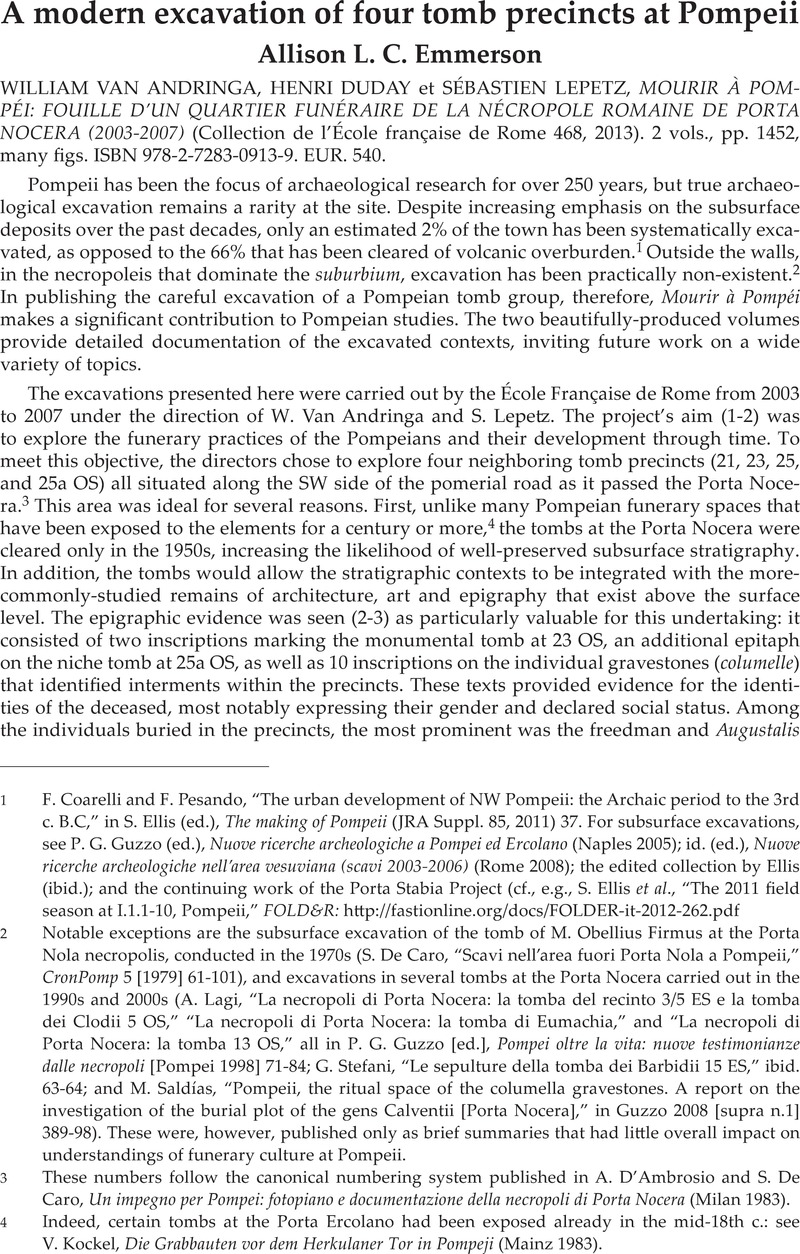No CrossRef data available.
Article contents
A modern excavation of four tomb precincts at Pompeii - WILLIAM VAN ANDRINGA, HENRI DUDAY et SÉBASTIEN LEPETZ, MOURIR À POMPÉI: FOUILLE D'UN QUARTIER FUNÉRAIRE DE LA NÉCROPOLE ROMAINE DE PORTA NOCERA (2003-2007) (Collection de l’École française de Rome 468, 2013). 2 vols., pp. 1452, many figs. ISBN 978-2-7283-0913-9. EUR. 540.
Published online by Cambridge University Press: 27 November 2014
Abstract

- Type
- Reviews
- Information
- Copyright
- Copyright © Journal of Roman Archaeology L.L.C. 2014
References
1 F. Coarelli and F. Pesando, “The urban development of NW Pompeii: the Archaic period to the 3rd c. B.C,” in S. Ellis (ed.), The making of Pompeii (JRA Suppl. 85, 2011) 37. For subsurface excavations, see Guzzo, P. G. (ed.), Nuove ricerche archeologiche a Pompei ed Ercolano (Naples 2005)Google Scholar; id. (ed.), Nuove ricerche archeologiche nell’area vesuviana (scavi 2003-2006) (Rome 2008); the edited collection by Ellis (ibid.); and the continuing work of the Porta Stabia Project (cf., e.g., S. Ellis et al., “The 2011 field season at I.1.1-10, Pompeii,” FOLD&R: http://fastionline.org/docs/FOLDER-it-2012-262.pdf
2 Notable exceptions are the subsurface excavation of the tomb of M. Obellius Firmus at the Porta Nola necropolis, conducted in the 1970s ( Caro, S. De, “Scavi nell’area fuori Porta Nola a Pompeii,” CronPomp 5 [1979] 61–101)Google Scholar, and excavations in several tombs at the Porta Nocera carried out in the 1990s and 2000s (A. Lagi, “La necropoli di Porta Nocera: la tomba del recinto 3/5 ES e la tomba dei Clodii 5 OS,” “La necropoli di Porta Nocera: la tomba di Eumachia,” and “La necropoli di Porta Nocera: la tomba 13 OS,” all in P. G. Guzzo [ed.], Pompei oltre la vita: nuove testimonianze dalle necropoli [Pompei 1998] 71-84; G. Stefani, “Le sepulture della tomba dei Barbidii 15 ES,” ibid. 63-64; and M. Saldías, “Pompeii, the ritual space of the columella gravestones. A report on the investigation of the burial plot of the gens Calventii [Porta Nocera],” in Guzzo 2008 [supra n.1] 389-98). These were, however, published only as brief summaries that had little overall impact on understandings of funerary culture at Pompeii.
3 These numbers follow the canonical numbering system published in D'Ambrosio, A. and Caro, S. De, Un impegno per Pompei: fotopiano e documentazione della necropoli di Porta Nocera (Milan 1983)Google Scholar.
4 Indeed, certain tombs at the Porta Ercolano had been exposed already in the mid-18th c.: see Kockel, V., Die Grabbauten vor dem Herkulaner Tor in Pompeji (Mainz 1983)Google Scholar.
5 In addition to the two monumental inscriptions relating to him, Vesonius's presence in the tomb precinct was attested by his columella, a cippus (boundary-marker) found in front of tomb 23 OS that was inscribed with his name, and a mortar floor partially preserved in the niche at the rear of the monumental tomb that featured inset pieces of stone spelling P VES. Other columelle inscriptions identified members of his family.
6 The excavated data challenges D'Ambrosio and De Caro's (supra n.3) Julio-Claudian date for the monumental tomb of P. Vesonius Phileros at 23 OS. That the monument was constructed no earlier than the Flavian period invites a re-appraisal of their 1983 chronology, which was based largely on typology and portrait styles.
7 The publication of current excavations at the Porta Mediana necropolis at Cumae, also under the auspices of the French School, will provide valuable comparative material: cf. Brun, J.-P. and Munzi, P., “La necropoli monumentale di età romana a nord della città di Cuma,” AttiTaranto 48 (2009) 637–717 Google Scholar.
8 Given that this is the first systematic excavation and publication of pyre remains at Pompeii, it is regrettable that the work schedule did not allow for full exploration of both pyre areas discovered within the precincts.
9 This section does not refer to the tombs at the Porta Sarno, where canine and equine bones were also recovered and interpreted as waste unrelated to funerary activities: Ambrosio, A., “Notiziario: scavi e scoperte nel suburbio di Pompei,” RStPomp 9 (1998) 197–99Google Scholar, and “Notiziario: suburbio orientale,” RStPomp 10 (1999) 180–82Google Scholar.
10 Plans detailing find locations of artifacts and ecofacts suggest a strong funerary association only for balsamaria, which tended to cluster around the columelle (see 929, fig. 476a).
11 See Wallace-Hadrill, A., Rome’s cultural revolution (Cambridge 2011)Google Scholar. For the particular problems of attributing Roman origin to Pompeian funerary practices, see Kockel, V., “Im Tode Gleich? Die Sullanischen Kolonisten und ihr kulturelles Gewicht in Pompeji am Beispiel der Nekropolen,” in von Hesberg, H. and Zanker, P. (edd.), Römische Gräberstraßen: Selbstdarstellung—Status—Standard (Munich 1987) 183–98Google Scholar.
12 Petersen, L. Hackworth, The freedman in Roman art and art history (Cambridge 2006) 1–11 Google Scholar.
13 E.g., Lepetz, S. and Van Andringa, W., “Publius Vesonius Phileros vivos monumentum fecit: investigations in a sector of the Porta Nocera cemetery in Roman Pompeii,” in Carroll, M. and Rempel, J. (edd.), Living through the dead: burial and commemoration in the classical world (Oxford 2011) 110–33Google Scholar.




